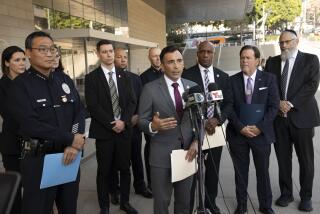Teen Guilty in Tay Murder Case : Courts: Jury quickly convicts Robert Chan in trial that shocked O.C. Another youth enters a surprise guilty plea. Jury selection starts for two remaining defendants.
- Share via
SANTA ANA — A jury took less than three hours Tuesday to find a teen-ager guilty of first-degree murder for orchestrating the 1992 New Year’s Eve ambush slaying of high school honors student Stuart A. Tay.
Robert Chan, 19, of Fullerton, a onetime candidate for valedictorian, now faces life in prison without parole for his role in Tay’s death. The 17-year-old Orange resident was beaten with baseball bats, forced to swallow rubbing alcohol and then left to die in a shallow grave in a Buena Park back yard.
The murder and subsequent arrests of Chan and four other high school students--most of them ambitious, college-bound seniors--shocked Orange County. Two of them are awaiting trial, another admitted his guilt earlier and, in a surprise move, a fourth teen-ager pleaded guilty Tuesday, just hours before Chan’s conviction.
“I was surprised at how fast the verdict took, but there was really nothing to decide,” said juror Ulla Laing of Huntington Beach. “He got on the witness stand and said he did it and he knew what he was doing. It’s like the prosecutor said--he convicted himself.”
Jurors in the Chan case said they agreed with the district attorney’s contention that Chan sealed his conviction when he testified that he knew the killing was wrong, but still joined four other teen-agers in killing Tay.
The prosecution alleged that Chan masterminded the murder because he believed Tay was about to double-cross him in a plan to rob an Anaheim computer parts dealer. The plan unraveled when Chan discovered that Tay was lying to him about his name, age and background and feared that Tay was a police informant.
Chan, who was described during the trial as a paranoid schizophrenic, denied plotting the killing. But he told jurors he assisted in the murder because he believed Tay had rigged Chan’s home with explosives and was about to kill him unless stopped.
But one juror, who spoke only the condition of anonymity, said the jury readily rejected Chan’s defense.
“There was no doubt that he was the mastermind,” the juror said. “He tried to lie and blame others for it, but if there was no Robert Chan, Stuart Tay would still be alive today.
“Even if we wanted to give him a break, our conscience wouldn’t let us,” the juror said. “He was not (mentally unstable). He knew what he was doing.”
The juror said the tragedy of the case was “that two lives of two bright kids have been wasted. Tay is dead and Chan is probably going to spend the rest of his life in jail.”
The case has gained widespread attention, both as a symbol of juvenile crime out of control and because both teen-agers came from seemingly model homes. Chan was a top student at Sunny Hills High School in Fullerton and his IQ hovered near the genius level. Tay, who attended Foothill High School in Santa Ana, aspired to become a physician like his father. Tay’s mother, Linda, said she was grateful that the jury saw through Chan’s defense. “I did expect a very early verdict because the facts were clear,” she said.
“Even the best carpenter cannot build a house without wood,” she added in reference to the prominent Orange County attorney who represented Chan.
Chan’s parents were devastated.
“I just want to say this is a tragedy for everyone,” said Tony Chan, a Fullerton engineer who said his son bears responsibility in the killing but questioned whether he received a fair trial. “I didn’t say he’s innocent, but a lot of things Mr. D.A. says are not correct.”
Sentencing for Chan is June 3.
As jurors began deliberating Chan’s fate Tuesday, Mun Bong Kang, now 19, pleaded guilty to first-degree murder for assisting in the ambush attack. His parents had urged the plea, said defense attorney Ronald G. Brower, who represents Kang.
“They wanted to do the honorable thing,” Brower said. “They and their son hope this act will in some small way convey their true feelings and the shame they feel. They pray daily for God to ease the suffering of the Tay family.”
Orange County Superior Court Judge Kathleen E. O’Leary will decided at a later date whether Kang, who was a juvenile at the time of the killing, will be sentenced to state prison or the California Youth Authority.
Jury selection from a pool of 400 people began Tuesday for the remaining two co-defendants: Abraham Acosta, 17, of Buena Park and Kirn Young Kim, 18, of Fullerton. Judge O’Leary dismissed the majority of the prospective jurors, saying she was concerned that information about the verdict would taint their objectivity. The key prosecution witness in Chan’s trial was Charles Choe, 18, of Fullerton, who admitted participating in the murder but said he did not strike Tay. He is cooperating with prosecutors and is expected to be released from the California Youth Authority when he turns 25.
Deputy Dist. Atty. Lewis R. Rosenblum told jurors in his closing arguments Monday that they could disregard the prosecution’s evidence that Chan was the ringleader and still find enough evidence from the defendant’s own mouth to convict him as an accomplice.
Defense attorney Marshall M. Schulman said outside court that he believes Rosenblum’s argument was improper, and that it lays the foundation for an appeal. Schulman said he also believes the lack of Asians on the grand jury that indicted his client will play a role in an appeal.
Schulman had asked jurors to convict his client of the lesser charge of voluntary manslaughter. He employed a theory of “imperfect self-defense,” meaning that his client had believed--wrongly but honestly--that his life was in danger.
Despite juror comments that Chan was his own worst witness, Schulman said he had no doubts about putting his client on the witness stand.
“It was the only way to present a defense . . . he had to testify to what he believed at the time,” Schulman said.
The defense attorney also told jurors that some of the blame rested with the victim.
The defense contended that Tay tried to impress his new friends by claiming to be a 19-year-old crime figure with dozens of followers and involvement in illegal activities, including counterfeiting and weapon sales.
Such bragging fed Chan’s mental impairment and convinced him he had to kill or be killed, Schulman said.
Outside court Tuesday afternoon, Linda Tay quietly disagreed.
“I don’t see how Stuart could be responsible for what happened to him,” she said.
She said she is bracing for the second trial, which may get underway next week.
“It’s painful, but it’s something I have to do,” she said.
Times staff writer Davan Maharaj contributed to this story.
Tale of Ambush Murder
Dec. 31, 1992: About 4 p.m., Stuart A. Tay leaves home in Orange, telling his sister he must run an errand.
Jan. 1, 1993: About 2:40 a.m., Tay’s mother telephones Orange police to report him missing. About 9:50 p.m., Compton police find Tay’s car stripped and abandoned.
Jan. 2: A friend of Tay’s tells Orange police that Tay mentioned buying a handgun from a student named Robert Chan and that Chan and Tay agreed to meet at 4 p.m. on New Year’s Eve.
Jan. 4: Based on information from a private investigator hired by the Tay family, police arrest Abraham Acosta, Kirn Young Kim, Robert Chan and Mun Bong Kang, students at Sunny Hills High School. Soon after, they arrest Charles Choe, also a Sunny Hills student. Chan refuses to talk; others tell how they lured Tay to Acosta’s garage, beat him and buried his body.
March 29: Superior Court Judge Kathleen O’Leary grants Chan a separate trial.
July 30: Choe is sentenced to eight years in custody of California Youth Authority.
April 4, 1994: Jury selection begins in Chan’s trial.
April 7: Choe testifies that Chan orchestrated Tay’s bludgeon murder and burial.
April 25: Psychologist Francis M. Crinella testifies that Chan suffers from paranoid schizophrenia and was convinced that Tay had rigged his home with explosives that could detonate at any time.
April 27: Chan testifies that he helped four others bludgeon Tay and bury his body.
May 3: Chan is convicted of first-degree murder with special circumstances. He faces life in prison with no prospect of parole.
Source: Times reports
Researched by CAROLINE LEMKE / Los Angeles Times
More to Read
Sign up for Essential California
The most important California stories and recommendations in your inbox every morning.
You may occasionally receive promotional content from the Los Angeles Times.














